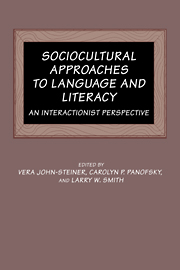Book contents
- Frontmatter
- Contents
- List of contributors
- 1 Introduction
- Part 1 Context
- 2 An interactionist approach to the analysis of similarities and differences between spoken and written language
- 3 Repair in spontaneous speech: A window on second language development
- 4 Struggling for a voice: An interactionist view of language and literacy in Deaf education
- Part II Mediational processes
- Part III Functional systems
- Author index
- Subject index
3 - Repair in spontaneous speech: A window on second language development
Published online by Cambridge University Press: 05 November 2011
- Frontmatter
- Contents
- List of contributors
- 1 Introduction
- Part 1 Context
- 2 An interactionist approach to the analysis of similarities and differences between spoken and written language
- 3 Repair in spontaneous speech: A window on second language development
- 4 Struggling for a voice: An interactionist view of language and literacy in Deaf education
- Part II Mediational processes
- Part III Functional systems
- Author index
- Subject index
Summary
The language learner must make his raincoat in the rain.
(Klein 1986)Language use is the crucible of language development.
(Langacker 1987)INTRODUCTION
Consider the following sample of speech from a learner of English as a second language:
He … receive … He received … his friend … from his friend … He received the letter from his friend.
The learner certainly gets his idea across, though, as we might expect from a learner, with hesitations, repetitions and adjustments, that is, repairs.
Or consider the following exchange during a lengthy conversation between another learner of English and a native speaker of English. The learner is describing his custom of watching the news on television, but is not sure of how to label a particular news segment:
Learner: (I watch) brief news. How say this … “brief news”?
Native speaker: Yeah, news in brief.
Learner: Ah … news in brief.
This conversational exchange involves collaborative repair, or otherrepair, as contrasted with the previous example of self-repair.
In this chapter, I argue that both kinds of repair (self-and other-) are instrumental in the development of oral proficiency in the target language. These spontaneous repairs in the speech of second language learners do not present themselves simply as corrections. They represent an expansion of the language resources of the learner during the process of language use in social context.
- Type
- Chapter
- Information
- Sociocultural Approaches to Language and LiteracyAn Interactionist Perspective, pp. 82 - 108Publisher: Cambridge University PressPrint publication year: 1994
- 8
- Cited by



